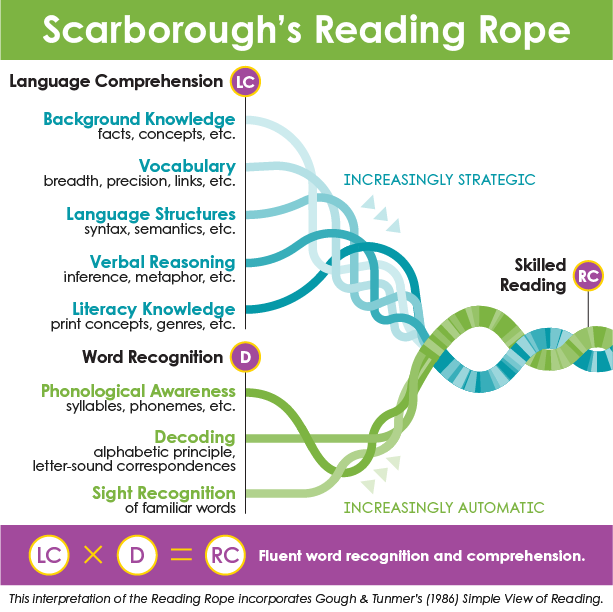Can Scarborough's Reading Rope Transform the Approach to Literacy Instruction?
The Science of Reading uncovers the intricate ways that our brains learn to read. Scarborough’s Reading Rope is one of the most approachable ways to better understand the complex processes of what is happening in our brains as we are learning to read. The Reading Rope model offers a clear framework to help us better understand the intricacies of reading.
How long has the Reading Rope model been around?
In the early 1990s, Dr. Hollis Scarborough invented the Reading Rope model. This model was developed with the goal of helping parents better understand the necessary skills that their children needed to develop to become proficient readers. In the original model Dr. Scarborough used pipe cleaners to convey how the different “strands” of reading are all interconnected yet independent of one another. For many students, learning to read is a challenge and Scarborough's Rope captures the complexity of learning to read. The Handbook of Early Literacy Research published Dr. Scarborough’s Reading Rope in 2001. Since then, this framework has become a staple for many reading teachers.
Scarborough's Reading Rope is made up of lower and upper strands. When all these component parts intertwine it results in skilled and accurate, fluent reading with strong comprehension.
The Upper Strands Include:
- Background knowledge
- Vocabulary
- Language structures
- Verbal reasoning
- Literacy knowledge
The Lower Strands Include:
- Phonological awareness
- Decoding
- Alphabetic principle
- Letter-sound correspondences
- Sight recognition

The Upper Strands
Background Knowledge
Background knowledge is an essential component in learning because it helps us make sense of new ideas and experiences. Readers rely on background knowledge to attend to and make sense of what they are reading. This is especially important for readers who are still relying heavily on word decoding rather than rapid word recognition. Having knowledge about a variety of subjects, topics, and ideas makes it more likely that they will be able to make sense of what they are reading and more likely that they will add to their body of knowledge.
Vocabulary
An extensive and rich vocabulary enables readers to make sense of what they are reading. A reader with rich auditory and oral vocabularies will find it easier to read through texts that contain words they have not seen in print before. If the student can use their growing decoding skills and match their result with a word they already know the meaning of, they will be more confident in their abilities and will spend less overall effort on reading a text.
Language Structures
Syntax - The arrangement of words in a phrase or sentence. The English language has patterns and rules for the way we order our words. It also has some flexibility and variety in acceptable patterns, and even then, speakers and writers are allowed some leeway with these patterns.
Semantics - In linguistics, semantics is the study of the meanings of morphemes, words, phrases, and sentences. Knowledge of the meaning of a text is essential to reading.
Verbal Reasoning
Inference - a conclusion one can draw from known facts or evidence
Metaphor - a word or phrase used to say that something is another thing in order to suggest that they are simila
Literary Knowledge
Print Concepts - letters vs. words, 1:1 correspondence, reading left-to-right and top-to-bottom, spaces between written words, letter order matters, etc.
Genres of Literature - different types of books or stories defined by special characteristics
The Lower Strands
Phonological Awareness
Phonological Awareness is a skill set that includes identifying and manipulating units of oral language – parts such as words, syllables, onsets, and rimes. Did you know that you can improve your students’ ability to read unfamiliar words without showing them a single printed letter?
Decoding
Decoding is the ability to apply knowledge of sound-letter relationships (phonics) to correctly pronounce written words. Did you know that in 2019, only 35% of 4th graders were at or above (NAEP) proficient level on the reading assessment?
Sight Recognition
Our sight word memory is also referred to as our orthographic lexicon, which includes all the words we can read accurately and effortlessly. Literate adults have a sight word memory of 30,000 to 70,000 words. Starting in 3rd grade, it is estimated that “skilled orthographic mappers” anchor 10-15 new words a day into their sight word memories. Sight word recognition is foundational to fluent reading.
Connecting Strands to Literacy Success
Scarborough's Reading Rope illustrates how skilled reading relies on the intertwining of language comprehension and word recognition. Each strand—like phonological awareness, decoding, vocabulary, and background knowledge—works together, gradually strengthening to create fluent, meaningful reading. As educators, using the Reading Rope framework helps us focus on building these essential components in a balanced, structured way, ensuring that students not only decode words but also fully understand and engage with the text. By addressing each strand, we help students develop into confident, capable readers equipped for lifelong literacy success.
Bring the Science of Reading to Life in the Classroom
Explore our engaging foundational reading approach. Avoid special education referrals, and jumpstart student outcomes across the curriculum.
- Professional Development - FREE for educators! Join us on a complimentary seat to one of our Science of Reading Virtual Workshops
- Diagnose - FREE assessments (K-12) to help identify decoding issues contributing to comprehension weaknesses
- Group - FREE, secure student data management interface for grouping K-12 students for instruction
- Teach - Explore our lessons, Launchpad (PK), Countdown (K), Blast (1st), HD Word (2nd-12th)


